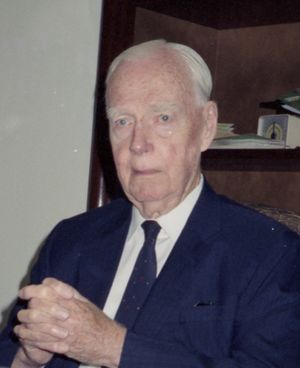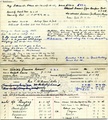Graham Robert Torrible
Contents
Biography
Graham Torrible was born in 1904 and joined The China Navigation Company as a deck officer in 1925. He served on the China Coast and Yangtze River during the 1920s and 1930s and was interned at Bangkok during the Second World War. He was Acting Marine Superintendent of C.N.Co. at Shanghai from 1948 until 1950. Torrible returned to sea in 1950 to take command of C.N.Co.'s new passenger liner Chungking III, on charter to Messageries Maritimes for their Marseilles/Tahiti/Sydney service.
In 1953, he was appointed Marine Superintendent of C.N.Co. at Hong Kong. On being appointed, one of his aims was to improve the relationship between the deck and engineering departments, which was not always satisfactory. He retired from the Company in 1961. Initially he returned to the UK on his retirement but is recorded as having told a friend "how unhappy and unsettled he felt when he retired back to the UK...." He said he felt that he was on a different wave-length from the British who had not ventured abroad, and found them very insular..." When the opportunity arose Torrible lept at the opportunity to return to Hong Kong and he died there in 1995
Capt. Torrible was awarded the O.B.E. in the 1961 Birthday Honours List, was a made a Freeman of the City of London and a Liveryman of the Honourable Company of Master Mariners.
Torrible recorded his experiences with C.N.Co. between 1925-1939 and the first edition of his "Yangtze Reminiscences" was published in 1975. The second edition was published in January 1990.
N.B. Graham Torrible's father William Harry Torrible, born in County Down Ireland, was also a Master Mariner. His uncle Alfred Torrible also born in County Down, was also a Master Mariner and sailed with CNCo.
Service
April 30th. 1925. Joined the China Navigation Co. holding the 1st. Mate's Certificate, seniority dating from June 30th. 1925, and promoted to Chief Officer on 5th.January 1929. When on leave he obtained his Master's Certificate No. 29898 in Liverpool on 11th. September 1930. Employed on various vessels operating on the China Coast and on the Yangtse River as required.
January 1st.1934 the Shasi II, on which he was Chief Officer, grounded half a mile above Boulder Rock, Lower Yangtse River. The pilot was reprimanded and warned, no blame attached to the Master.
May 27th. 1934. Upper Yangtse River. A deeply laden junk foundered in broken water caused by the wash from the "Wanhsien". The Junk was found to be at fault.
On his return to CNCo, after WW2 he sailed as Master on the Shengking II, Szechuen III, Taiyuan III, Chungking III.
Events / Stories
CROSSING A RAPID IN A SMALL COAL-BURNING SHIP Extracted from Yangtze Reminiscences, by Captain G.R. Torrible, O.B.E.
There is a sort of disciplined tension when approaching a rapid which, from the Water Mark, is known to be a difficult one. A mile or two below the rapid, the steam gauge on the bridge starts to rise, indicating that fires have been cleaned and the build-up under the water tube boiler has started. The ship will be travelling at a fair speed close to the rocky bank and the speed will slowly increase as the backwater increases.
The noise of the rapid will now be heard above the increasing throb of the engines. The number two pilot may be in charge until nearing the foot of the rapid. The number one then comes on the bridge and silently stands
beside him for a while, until the number two signals a firm “steady” to the helmsman, and swiftly leaves the bridge to join the “boatmen”, standing-by on the lower deck with their bamboo sounding poles.
Meanwhile, the whole of the engine room staff has been called and is on duty. They are all, with the exception of the Scottish Chief Engineer, Shanghai men. The Chief and Fourth Engineers are on the starting platform, the Third is in the stokehold, in which a double watch of firemen are working in organised harmony to bring the fires to perfection. The Second Engineer is at a vantage point where he can watch the shoreline and pass back information on progress. The fires have to reach peak performance as the ship reaches the head of the rapid, not before, and his job is to discourage too much enthusiasm, until the right moment – rather like a rowing coach on the bank of a river. Six greasers, with oil-cans in hand, are standing at six “legs” of the two triple-expansion engines. The ship is travelling along the backwater at increasing speed and the safety valve is lifting.
Now comes the moment of high drama, the smooth tongue of the rapid is ahead, crossing the bow diagonally
from the shore.
The pilot pulls back the long sleeve of his gown and gives a stern backward glance to the helmsman. (Steering
orders are passed in silence, normally by the movement of the forefinger, but emphasis is needed when entering a rapid.)
The Master telegraphs down for absolute full speed, the bow touches the tongue and the pilot with a dramatic
gesture brings the helm hard over to meet it. There is a confused rush of water, as though a sluice had been opened and the low forecastle disappears from view under a mass of foaming water. The ship quickly surfaces and is now almost at a standstill in the centre of the tongue, near what we could call the throat. She then moves slowly forward to the head.
In the engine room, the control valves are opened to their fullest extent, the fires are professionally handled in an attempt to lift the safety valves, thus indicating that the ship is “flat out”. The six greasers pour oil on six connecting rods, and, strangely enough, there is no sound other than the throb of the engines and the whisper of steam from the safety valve.
There is no bow wave, the ship appears to be at anchor in a mill pond. The pilot’s job now is to get her over the hump, that is, the build-up of water at the head of the rapid. The ship has already been loaded, unlike ships elsewhere, several inches by the head, so that once the bow is across,
the stern is not such a drag.
Incidentally, the “slope” of a really bad rapid can be six or seven feet in the length of the ship or, on the worst possible occasion, in several yards.
The pilot now gently moving his forefinger, eases the ship from one side of the head to the other. The head of a rapid, lying across the river, does not necessarily do so at right angles to the bank. The ship is therefore guided from side to side, holding her own, but eventually getting her forepart across the built-up water forming the head. She then moves slowly forward, she is over, tension relaxes, the number two, who has been watching the boatmen poling with bamboos, as the ship tries to get as close as possible to the rocky shores, relieves the number one. The steam gauge drops so low as fires are rebuilt, that the pressure is
insufficient to blow the whistle.
The trackers on the bank, hopeful until the last that the ship will not make it and will have to pass a wire
ashore to heave the last few yards, (she may hang on the top for half an hour, especially if she is oil fired, before making those vital few yards), take their loss in good part, which however can tend sometimes to be expressed with Rabelaisian humour - to the embarrassment of the more God-fearing passengers.
Should it be necessary to heave the rapid, then the ship is held close to the bank, the end of the heaving wire is passed through the large heaving sheave, set well back on the forecastle, and then to the waiting trackers, who make it fast to a convenient place, well above the rapid, and the wire is brought to the large low-geared heaving-capstan and hove tight. When all is ready, the pilot eases the ship further from the shore, the taut wire springs the ship slightly ahead (the engines of course are still at full speed) then, at a given signal, the ship is brought back towards the shore and the slack is taken up by the capstan. A few evolutions like this and the ship is over the head. The wire is picked up and the ship waits in the calm above the rapid for the trackers’ sampan to collect the fee, which, paid in silver dollars, is quite a windfall for the village.


